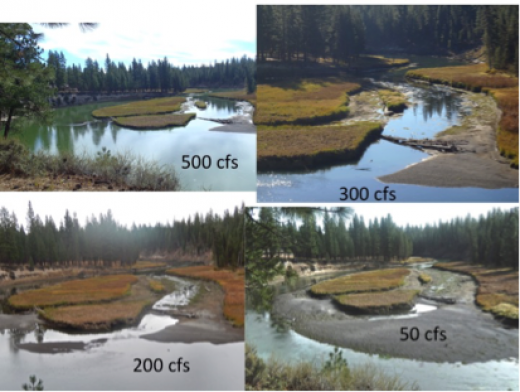2015 Chapter Report
Annual Meeting Oct 29th, Bend OR.
Featured speaker:
Fish biologist Nick Weber, Ecological Research, provided insights about novel approaches to stream restoration. The case study of Bridge Creek in the John Day basin, with use of beaver dam analogs, was of particular interest.
Basin activities:
Lower Deschutes
Changes in water quality and algal problems in the lower river are generating increased discussion. The Deschutes River Alliance convened a "summit of NGOs" last month in Portland. Scott Yates, Chandra Ferrari and Mike Tripp represented TU. TU is engaged as a signatory on the Pelton Round Butte FERC re-licensure agreement. The data generatd by DRA is impressive, and the DRA has another aggressive plan of studies prepared for 2016. v Questions now are how to engage PGE and the Tribes productively, and how to engage DEQ on a basin wide nutrient cycling problem.
Crooked River
Jobs and Security Act legislation. Implementation is encountering some challenges, which are made more difficult by the drought. The Reclamation drought management plan called for in the legislation has not been developed. Reclamation's approach to the required water rights re-characterizations is being reviewed. The water release for fish schedule, supervised by BOR and USFW, is a work in progress. So it seems clear that this major legislative act for water management on the Crooked merits continued involvement.
Opal Springs fish passage. Much activity and controversy this year focused on funding. Deschutes Valley Water District has proceeded with application to amend their FERC license, which is widely heralded as a necessary step for funding commitments. ODFW through the ODOT mitigation fund secured a $1.2M commitment to follow OWEB's $1M commitment. Expect more pressure on the funding challenge. More details can be found on several web sites.
Embrace A Stream grant. Chapter success with EAS grants has been good. Deschutes #552 has prepared another EAS application for a project on Ochoco Creek just above Prineville.
Metolius
In the wrap up stages of Darek's successful collaborative project with USFS on > 70 user impacted sites.
Upper Deschutes
Oregon spotted frog. ESA listing has led to threatened legal actions by the Center for Biologic Diversity and by WaterWatch. Other developing controversies merit monitoring.
The modified ramp down study of last fall has garnered much attention. It has been the subject of at least 3 programs in Central Oregon and was the subject of an article by Chris Santella in Trout this summer. Its results bear directly on spotted frog discussions, and the Habitat Conservation Plan being pursued by the irrigation districts. It will complement the Basin Study.
Lava Island fish salvage 2015. Completed this month. The somewhat scaled down effort salvaged 3,440 trout vs 5105 trout in 2014. Good publicity for the plight of the Upper D!
Reclamation Basin Study. In progress; reports can be viewed online. Funding of $1.5M has been supplemented by >$1M through the Farm Conservation Alliance via the Energy Trust of Oregon for further work within the IDs.. Details can be delved into on request and at multiple web sites. The Basin Study is a critical step towards restoration of the Upper D.
Fall River work. The prior EAS grant working with graduate student Levi Olds was very successful, and led to securement of a $40K 2 year grant from Oregon State Parks for education and work on user impacted sites. We continue to work with ODFW on figuring out why the recreational fishery on the Fall has deteriorated. Board member Paul Burton continues discussions with motivated homeowners, and a macro invertebrate study.
Chapter status.
Our 2015 goal of stabilization of current activities was met. The board recognizes that our chapter must develop additional resources if we are to engage our mission more aggressively. Your input and participation is welcome and very needed.


